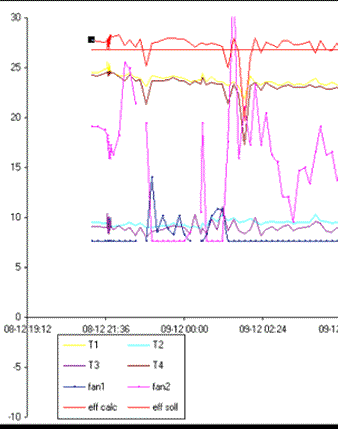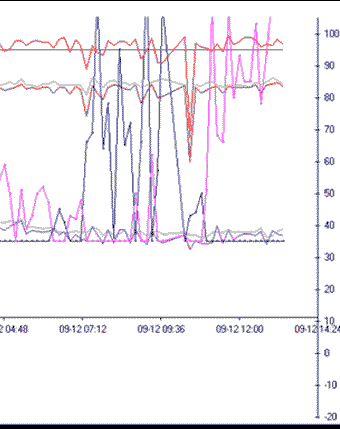|
|
|
|
|
|
|
|||||||||
|
|
|
|||||||||||||
|
|
|
|
||||||||||||
|
|
|
|||||||||||||
|
|
|
|
|
|
|
|
|
|
||||||
|
|
|
|||||||||||||
|
|
|
|
||||||||||||
|
|
|
|
|
|
|
|
|
|
|
|
|
|
|
|
|
|
|
|
|||||||||
|
|
|
|
|
 |
|||||||
 |
 |
||||||||||
|
|
|
||||||||||
|
|
|||||||||||
|
|
|
|
|||||||||
VALIDATION OF MEASUREMENTS
According to the calculations the prototype, being tested in Iceland appeared to have an average heat-recovering efficiency of over 95% (the most upper curve). [4] This number of more than 95% efficiency calculated (the straight upper line) is some what flattering so one realises that some leakage in the heat exchanger
exists.
Two small reversible computerised fans could not cope with the extreme differences in air pressure (100-150 Pascal). During the test period we have easterly and westerly storm. The fans combine their capacity to keep the airflows in balance. Fan 1 (outer fan) runs fast reverse at storm leeward and also fan 2 cannot withstand the storm windward. The ventilation systems in large buildings also tend to lose their balance, as told me the director of a great ventilator factory. By closing the horizontal air supply and -exhaust ducts with heavy winds, in these circumstances there will be enough natural ventilation anyway.
CALCULATING ENERGY SAVING
HEATING COST REDUCTION PER HOUSE Footnote: 1 m3 natural gas corresponds energetically to 1 litre of petrol, therefore the saving of 468 m3 natural gas per house is comparable to 5000 kilometres in a luxury car. Around the world in eight years = 40.000 km.
|
|
ELECTRICITY CONSUMPTION Besides the savings of the heat exchangers the primary energy consumption of the two ventilators should be deducted. At an outside temperature of 0�C and an inside temperature of 20�C and 50 m3/hour ventilation per 'breathing window', the two ventilators use 8 Watts, but now with 95% heating regenerative efficiency. The thermal (low-calorie) energy saving is now: 50 / 3600 x 1212 x [20-0] x 0.95 = 320 Watts.
The high-quality 8-Watt electricity is produced by a traditional power station (not connected to district heating), with 40% efficiency amounting to 8 : 0.40 = 20 thermal Watts.
AIR RESISTANCE AND NOISE
|
|||||||||
|
|
|||||||||||
|
|
|
|
|
|
|
|
|
|
|
|
|